Review
by Theron Martin,Ghost Hunt
G.novel 2
| Synopsis: |  |
||
High school student Mai Taniyama has a curious part-time job: she's an assistant at SPR, aka Shibuya Psychic Research, a business that investigates and, where necessary, deals with strange phenomena. She works for Kazuya Shibuya, a serious, mysterious young man nicknamed “Naru” because of his narcissistic behavior, and regularly works with Naru's assistant Lin, an Australian exorcist named John Brown, the famous psychic medium Masako Haya, a self-proclaimed miko named Ayako, and Houshou Takigawa, aka “Monk-san” because he was once a monk. In their current case SPR is investigating a house haunted by poltergeists, a house where, in the past, numerous young children have died under unusual circumstances. The doll of their employer's niece, which has become possessed by evil spirits, seems to be behind the trouble, but could the psychic problems of the place run deeper still? |
|||
| Review: | |||
The Ghost Hunt manga is an adaptation of the similarly-named novel by Fuyumi Ono, the author better-known to American fans for the novels on which the anime series Twelve Kingdoms was based. This pedigree alone will probably encourage knowledgeable fans to check out this manga, but sadly this creation isn't as compelling as her Twelve Kingdoms content. Businesses which have been set up to investigate and put down ghosts date back at least to 1984's Ghostbusters movie, and ghost-hunting (with or without the business aspect) has been a recurring theme in anime and manga ever since. While fresh new spins on this recurring theme do occasionally come along, this isn't one of them. The only real selling point so far for American fans is the decidedly Japanese spiritualist take on dealing with ghosts and spirits, which may interest those used to more Western approaches. There's nothing done here that hasn't been done elsewhere and done as well or better, though. Most of this volume is comprised of the main “Doll House” story, which carries serious horror overtones occasionally broken by brief light-hearted moments, especially Mai's energetic reactions to things. Though she is not usually the impetus of the events in the story, the entire story is told from her point of view. The last chapter is a decidedly less serious one-shot side story which splits its time between a spirit in a park who dumps water on couples and speculating on character relationships within SPR. Sprinkled amongst the chapters of the main story, rather than collected at the end, are four-panel side strips which, according to a note by the manga-ka, take up the space used by advertisements and letters to the editor in the original magazine publication. The manga artistry, which marks manga-ka Shiho Inada's U.S. debut after a Japanese career dating back to the mid-90s, is sufficient to support the storytelling but unlikely to attract readers solely on its own merits. It creates an androgynous lead character whose gender can often only be visually substantiated by her miniskirt, although in some cases the casual tops she wears (she never appears in a school uniform in this volume) are also decidedly girly. Even the large eyes aren't a give-away, since John Brown also has them; although she's supposed to be Japanese and he's supposed to be Australian, they could be twins if they dressed the same, since both also have similar builds, hairdos, and facial structures. The artistry is also inconsistent on her hair color; her hair is given no shading in the panel artistry but appears in varying darker shades on the front and back cover art and in the chapter-heading art. Naru is the typical mysterious bishonen guy dressed in black, while Ayako, Masako, and Monk-san are more distinctive in appearance. Guest appearances are also usually more distinctive in design. The background artistry is light on shading much more often than one would expect for a story with such dark overtones, and also takes a minimalist approach to providing detail. Frequent use is made of chibi highlights in less serious moments but no fan service can be found here; only the dark nature of some content merits the 13+ age rating. Del Rey's translation makes a concerted effort to retain as much of the original Japanese feel of the writing as is feasible. It keeps the story flowing along well while also retaining the original use of honorifics, though it does flip names to conform to the Western standard. Some prayers and chants are not even translated into romaji because, as the end notes explain, making a workable translation of such old-style prayers would be quite difficult. Sound effects remain in their original form but small and unobtrusive (but still easily readable) translations are provided; this is an example of the best possible compromise between making them understandable and retaining artistic integrity. A section at the very beginning gives a novice's introduction to Japanese honorifics and a page in the first “File” lays out the set-up, main characters, and story so far, allowing readers to jump in on this volume without feeling like they've missed anything. At the end are several pages of illustrated translation notes followed by an untranslated preview of the third volume. All-in-all it is one of the better English productions of recent manga titles. Ghost Hunt isn't a bad series, as it does work in some effective drama and does a respectable job of handling the tension-breaking silly moments. Del Rey also does do an excellent job with its English production. It just isn't artistically impressive enough, or fresh or exciting enough in its storytelling, to distinguish itself in a crowded genre. |
| Grade: | |||
|
Story : B-
Art : B-
+ English production worthy of being the standard for judging other English productions of manga. |
|||
| Production Info: | ||
|
Full encyclopedia details about Release information about |
||